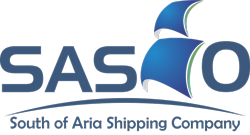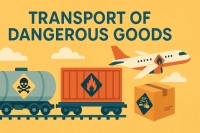Understanding Dangerous Goods
Dangerous goods, officially known as “hazardous materials” or HAZMAT, refer to substances that, if transported improperly, can pose a serious threat to human health, safety, property, and the environment. These materials can be in solid, liquid, or gaseous form and include substances such as toxic chemicals, explosives, pressurized gases, flammable liquids, and radioactive materials.
Safe transportation of these goods is of utmost importance, as any negligence can lead to incidents such as fires, explosions, environmental contamination, and personal injuries. For example, a leak of toxic chemicals can contaminate water and soil resources and threaten wildlife and natural ecosystems.
Therefore, international organizations such as the United Nations (UN) and the International Civil Aviation Organization (ICAO) have established standards for transporting these materials. These standards cover hazardous material classification, proper packaging, labeling, documentation, and personnel training.
Dangerous Goods Classes
The carriage of dangerous goods relies on internationally recognized systems such as the ADR (Accord Dangereux Routier), which provides a comprehensive framework for classifying and handling hazardous materials.
Class 1 – Explosives
This class includes materials capable of explosion or rapid combustion. It is subdivided into six categories based on the type of hazard:
- 1.1: Mass explosion hazard
- 1.2: Projection hazard
- 1.3: Fire hazard with minor blast
- 1.4: Minor explosion hazard
- 1.5: Very insensitive explosives
- 1.6: Extremely insensitive articles
Examples: military explosives, fireworks, fuses, sensitive chemicals.
Class 2 – Gases
Gases under pressure, whether compressed, liquefied, or dissolved, fall under this class:
- 2.1: Flammable gases (e.g., propane, butane)
- 2.2: Non-flammable, non-toxic gases (e.g., nitrogen, carbon dioxide)
- 2.3: Toxic gases (e.g., chlorine, ammonia)
Class 3 – Flammable Liquids
Liquids that produce flammable vapors at defined temperatures:
- Group I: Flashpoint ≤ 35°C
- Group II: Flashpoint < 23°C, boiling point > 35°C
- Group III: Flashpoint ≥ 23°C and ≤ 60°C
Examples: gasoline, alcohol, paint thinner.
Class 4 – Flammable Solids
Divided into three subgroups:
- 4.1: Flammable solids (e.g., hexamine)
- 4.2: Self-reactive substances (e.g., camphor)
- 4.3: Materials that emit flammable gases when in contact with water (e.g., sodium)
Class 5 – Oxidizing Substances and Organic Peroxides
- 5.1: Oxidizing agents that can accelerate combustion
- 5.2: Organic peroxides that can react violently
Examples: hydrogen peroxide, ammonium nitrate.
Class 6 – Toxic and Infectious Substances
- 6.1: Toxic substances harmful to humans
- 6.2: Infectious substances capable of causing disease
Examples: chemical toxins, viruses, bacteria.
Class 7 – Radioactive Materials
Substances that emit radiation and pose risks to humans and the environment.
Examples: medical isotopes, nuclear materials.
Class 8 – Corrosive Substances
Materials that can cause chemical burns to living tissue or other materials.
Examples: acids, alkalis, industrial chemicals.
Class 9 – Miscellaneous Dangerous Substances
Materials that do not fit into the other classes but remain hazardous.
Examples: environmentally hazardous substances, electronic materials under certain conditions.
Adhering strictly to dangerous goods regulations is essential in the transportation of dangerous goods and dangerous goods sea transport, ensuring safety, reducing risks of accidents, and complying with international standards.

Dangerous Goods Regulations and Standards
Below are direct links to official PDF documents on dangerous goods regulations and standards from key organizations such as IATA (air transport), IMO (maritime transport - IMDG Code), UNECE (UN Recommendations), ICAO (International Civil Aviation Organization), and DOT (U.S. Department of Transportation). These PDFs are official and up-to-date as of 2025.
Note: Full access may require registration or purchase in some cases, but the links point to free or sample files where available.
- IATA (International Air Transport Association) - Dangerous Goods Regulations: DGR 66th Edition (2025) Overview and Updates IATA DGR Packing Instructions (2025) (Updated for 2025 compliance).
- IMO (International Maritime Organization) - IMDG Code: IMDG Code 2022 Edition Errata (2025 Supplement) IMDG Code 2020 Edition Corrigenda (Updated 2025).
- UNECE (United Nations Economic Commission for Europe) - UN Recommendations: Recommendations on the Transport of Dangerous Goods, Rev. 21 Vol. I (2025) ADR 2025 Volume I (European Agreement on Dangerous Goods by Road).
- ICAO (International Civil Aviation Organization) - Technical Instructions: Technical Instructions for the Safe Transport of Dangerous Goods by Air, 2025-2026 Edition Revisions 2021-2022 Addendum (Updated for 2025).
- DOT (U.S. Department of Transportation) - Hazardous Materials Regulations: Hazardous Materials Regulations Overview (2025 Update) (With 2025 amendments). How to Use the HMR (Hazardous Materials Regulations, 2025 Guide).
- RID (Regulations concerning the International Carriage of Dangerous Goods by Rail, 2025 Edition): RID 2025 (OTIF).
Iran’s Regulations on Dangerous Goods Transportation
As a developing country in the transportation sector, Iran has established specific laws and regulations for transportation of dangerous goods through Iran that are primarily based on international standards, such as the UN Model Regulations, while also addressing national priorities like safety, environmental protection, and customs compliance.
The transportation of dangerous goods through Iran is overseen by multiple authorities, with specific requirements for registration, licensing, and monitoring. Iran applies similar regulations to RID for rail transport and UN standards for road transport, while the Ministry of Roads and Urban Development is responsible for aligning national legislation with ADR standards.
Regulatory Authorities Overseeing Dangerous Goods in Iran
Multiple regulatory bodies in Iran are responsible for transport of dangerous goods through Iran. The key authorities include:
- Islamic Republic of Iran Customs Administration (IRICA): IRICA plays a central role in monitoring the import, export, and transport of dangerous goods through Iran. The agency issues customs permits, reviews documents such as safety certificates and Material Safety Data Sheets (MSDS), and enforces transport restrictions, including air transport bans for certain items. For dangerous goods, IRICA requires ISIRI testing at designated ports, such as Bandar Abbas or Imam Khomeini Port, and ensures compliance with safety standards. In transit operations, IRICA coordinates with international organizations to ensure conformity with global regulations.
- Ministry of Roads and Urban Development (Road Maintenance & Transportation Organization): Responsible for road and rail transport regulations, issuing permits for drivers and vehicles, and implementing national regulations for dangerous goods.
- Department of Environment: Oversees environmental aspects of transport of dangerous goods through Iran, including preventing pollution caused by leaks or spills of hazardous materials.
- Institute of Standards and Industrial Research of Iran (ISIRI): Develops and enforces technical standards relevant to dangerous goods (details provided in the next section).
- Civil Aviation Organization & Ports and Maritime Organization: Regulate air and sea transport, with a focus on compliance with ICAO and IMDG standards.
These authorities coordinate their activities through platforms such as the National Dangerous Goods Committee and impose strict penalties for violations, such as improper labeling or documentation failures.
Packaging and Labeling Requirements under ISIRI Standards
The Institute of Standards and Industrial Research of Iran (ISIRI) serves as the sole official body for standardization in Iran and has established binding requirements for the packaging and labeling of dangerous goods, largely based on international guidelines such as the UN Recommendations. These standards are mandatory, and non-compliance can result in shipment detention.
- Packaging: Packaging must be strong, secure, and suitable for the type of hazard (Classes 1–9). Key standards include:
- ISIRI 11007: Packaging for the transport of dangerous goods – Intermediate Bulk Containers (IBCs) and large packages.
- ISIRI 11008: General requirements for inner and outer packagings, including drop tests, pressure resistance, and leak-proof performance.
- ISIRI 11007: Packaging for the transport of dangerous goods – Intermediate Bulk Containers (IBCs) and large packages.
Packaging must comply with UN codes (e.g., UN 4G for fiberboard boxes) and provide leak-proof protection for corrosive liquids. Materials such as metal, plastic, or wood must be of high quality to prevent explosions, leaks, or contamination.
- Labeling: Labels must display hazard symbols (UN diamonds), hazard class, substance name, UN code, manufacturer’s name, batch number, expiration date, and storage conditions (in English or Persian). Labels must be waterproof and clearly visible. For imported goods, an energy label (where applicable) is also required. ISIRI conducts mandatory testing to verify label durability and accuracy.
These requirements are consistent with the Globally Harmonized System (GHS) for classification and labeling of chemicals and are enforced by IRICA during customs clearance.
PDF Resources on the Transport of Dangerous Goods through Iran
Below you can download several PDF resources on the transport of dangerous goods through Iran, provided by official organizations:
- Islamic Republic of Iran Customs Administration (IRICA): PDF: Executive Bylaw on Road Transport of Dangerous Goods
- Ministry of Roads and Urban Development (Road Maintenance & Transportation Organization): PDF: Executive Regulations for Road Transport of Dangerous Goods
- Institute of Standards and Industrial Research of Iran (ISIRI): PDF: Conditions for the Transport of Dangerous Goods
Challenges in the Transportation of Dangerous Goods Through Iran
While Iran holds a strategic position in regional and international trade corridors, several obstacles affect the safe and efficient transportation of dangerous goods. Addressing these issues is essential for compliance with international standards and for ensuring safety.
1. Sanctions and International Restrictions
International sanctions have limited Iran’s access to advanced technologies, specialized vehicles, safety equipment, and global partnerships. This restricts compliance with some aspects of dangerous goods regulations and discourages foreign logistics companies from using Iran as a transit hub.
2. Lack of Adequate Infrastructure
Despite its strategic location, Iran faces shortages in modern infrastructure, such as specialized storage terminals, emergency response centers, and up-to-date road and rail fleets suitable for the carriage of dangerous goods via Iran. These gaps increase the risks of accidents and environmental damage.
3. Insurance and Liability Issues
Political and financial risks make international insurers hesitant to cover shipments transiting Iran. This raises shipping costs and creates legal uncertainty in the event of accidents, spills, or environmental damage.
Practical Solution
The most effective way to overcome these challenges is partnering with the best Iranian freight forwarders. These companies have extensive local expertise, know how to navigate sanctions, and are fully aware of the country’s infrastructure capabilities. They ensure that only shipments suitable for safe transport are accepted, while also coordinating with insurance providers to secure proper coverage. By relying on experienced Iranian forwarders, businesses can minimize risks and achieve safe, compliant, and cost-effective transportation of dangerous goods through Iran.
? If you are looking for a trusted partner with proven expertise, SASCO is ready to provide tailored solutions for the safe and reliable transport of dangerous goods through Iran.







